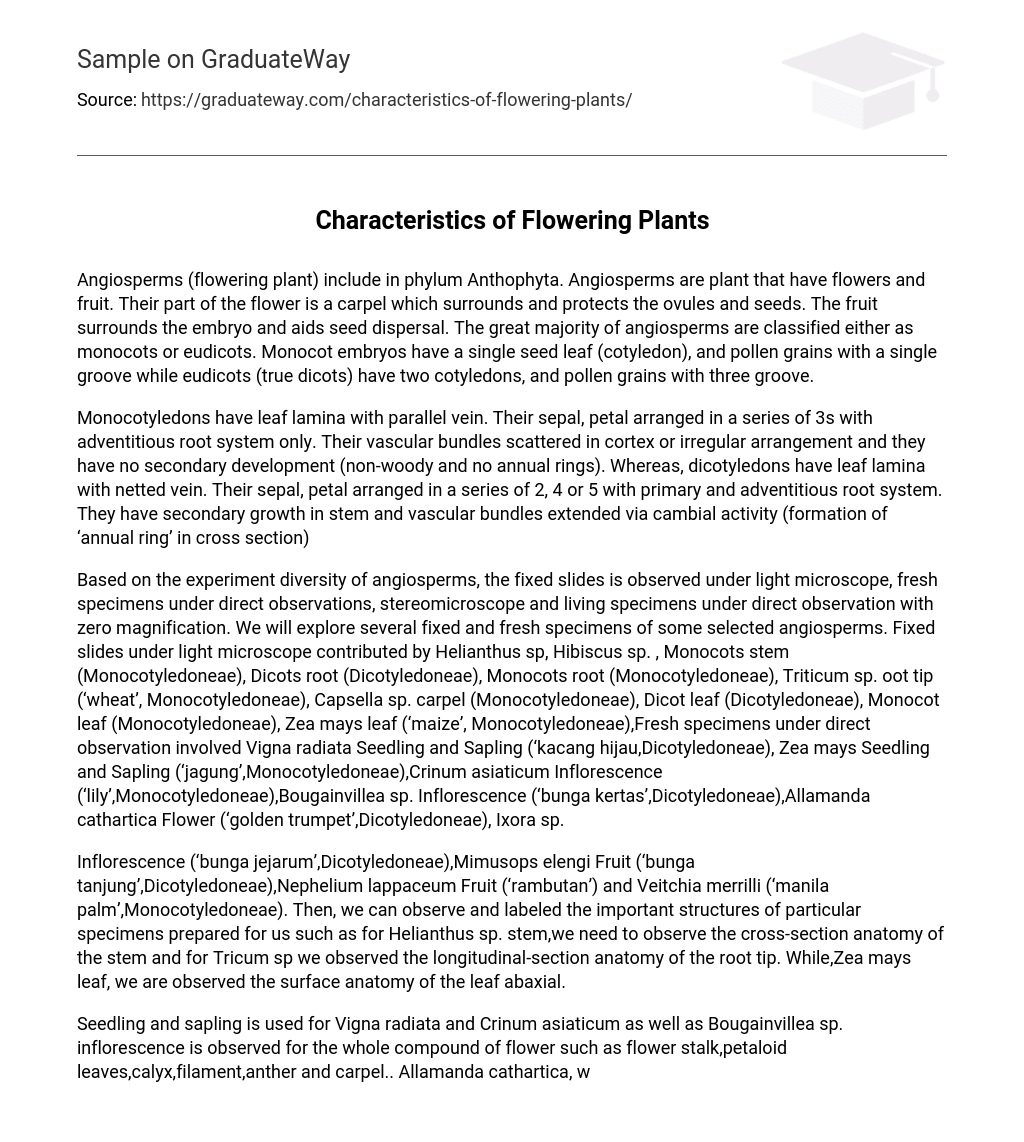Angiosperms, also known as flowering plants, are classified in the phylum Anthophyta. They are characterized by their possession of flowers and fruit. The carpel, a part of the flower, encloses and protects the ovules and seeds. Meanwhile, the fruit surrounds the embryo and helps with seed dispersal. The vast majority of angiosperms can be categorized as either monocots or eudicots. Monocot embryos have a solitary seed leaf (cotyledon) and pollen grains with a single groove, whereas eudicots (or true dicots) have two cotyledons and pollen grains with three grooves.
Monocotyledons have leaf lamina with parallel veins and a sepal and petal arrangement in a series of 3s. They have an adventitious root system and their vascular bundles are scattered in the cortex or arranged irregularly. Monocotyledons do not undergo secondary development and therefore do not have a woody stem or annual rings.
In contrast, dicotyledons have leaf lamina with netted veins and a sepal and petal arrangement in a series of 2, 4, or 5. They have both primary and adventitious root systems. Dicotyledons undergo secondary growth in their stems and their vascular bundles expand through cambial activity, resulting in the formation of annual rings in the cross section.
In the angiosperm diversity experiment, we used various observation methods. This included examining fixed slides under a light microscope, directly observing fresh specimens using a stereomicroscope, and observing living specimens without magnification. The range of specimens studied encompassed fixed slides from Helianthus sp., Hibiscus sp., Monocots stem (Monocotyledoneae), Dicots root (Dicotyledoneae), Monocots root (Monocotyledoneae), Triticum sp. root tip (‘wheat’, Monocotyledoneae), Capsella sp. carpel (Monocotyledoneae), Dicot leaf (Dicotyledoneae), Monocot leaf (Monocotyledoneae), Zea mays leaf (‘maize’, Monocotyledoneae). Additionally, fresh specimens were observed directly including Vigna radiata Seedling and Sapling (‘kacang hijau’, Dicotyledonous plants ), Zea mays Seedling and Sapling (‘jagung’, Monocotylenes ), Crinum asiaticum Inflorescence (‘lily’, Liliacean plants ), Bougainvillea sp. Inflorescence (‘bunga kertas’), Dicot leaves , Allamanda cathartica Flower (‘golden trumpet’). Also observed were Ixora sp. specimens.
In terms of plant specimens, we have Inflorescence (‘bunga jejarum’,Dicotyledoneae), Mimusops elengi Fruit (‘bunga tanjung’,Dicotyledoneae), Nephelium lappaceum Fruit (‘rambutan’), and Veitchia merrilli (‘manila palm’,Monocotyledoneae). We will be able to examine and classify these specimens by studying the important structures in them. For example, when analyzing the stem of Helianthus sp., we will focus on the cross-section anatomy. Conversely, for Tricum sp, we will study the longitudinal-section anatomy of the root tip. Lastly, in the case of Zea mays leaf, we will observe the surface anatomy of the leaf abaxial.
Seedling and sapling are terms used for Vigna radiata and Crinum asiaticum, as well as Bougainvillea sp. We observe the inflorescence of Bougainvillea sp., which includes the flower stalk, petaloid leaves, calyx, filament, anther, and carpel. When examining Allamanda cathartica, it is important to label the free calyx and fused corolla. In the case of Ixora sp., we observe the umbel inflorescence. For Mimusops elengi, we note the presence of a persistent calyx and stigma. The persistent stigma, pericarp, aril, and seed are labeled for Nephelium lappaceum. Lastly, we examine Veitchia merrilli and observe the whole fruit, including the dissected fruit with pericarp, aril, and seed.
The entire specimen or specific parts were successfully illustrated according to the provided instructions. Examples include illustrating the structures of Helianthus sp, Hibiscus sp. ,Crinum asiaticum Inflorescence (‘lily’,Monocotyledoneae),Allamanda cathartica Flower (‘golden trumpet’,Dicotyledoneae), Ixora sp. Inflorescence (‘bunga jejarum’,Dicotyledoneae),Mimusops elengi Fruit (‘bunga tanjung’,Dicotyledoneae),Nephelium lappaceum Fruit (‘rambutan’) and Veitchia merrilli (‘manila palm’,Monocotyledoneae). It is important for us to have a clear understanding of the depicted structures and their accurate labeling.
Next, we discussed the shared traits and distinguishing features of Angiosperms. The distinguishing features encompass monocotyledons and dicotyledons, the presence of a kernel, the germination of seedlings and saplings, persistent stigma and calyx, umble inflorescence, hypocotyls and epicotyls, axillary position on branches, petaloid leaves, hairy and erect stems, and fused corolla. The common characteristics include Triticum sp., Zea mays, Crinum asiaticum, and Veitchia merrilli for monocotyledons. As for dicotyledons, examples include Helianthus sp., Hibiscus sp., Capsella sp., Vigna radiata, Bougainvillea sp., Allamanda cathartica, Ixora sp., Mimusops elengi, and Nephelium lappaceum. Only Ixora sp. has an umble inflorescence, and only Triticum sp. and Zea mays have kernels among the monocotyledons. Zea mays and Vigna radiata represent seedling and sapling stages. Furthermore, we developed a taxonomic key based on the shared traits and distinguishing features of Angiosperms. We utilized a dichotomous key with conflicting choices (‘couplet’) and individual options (‘pointer’), employing bracketed key in this specific experiment.





